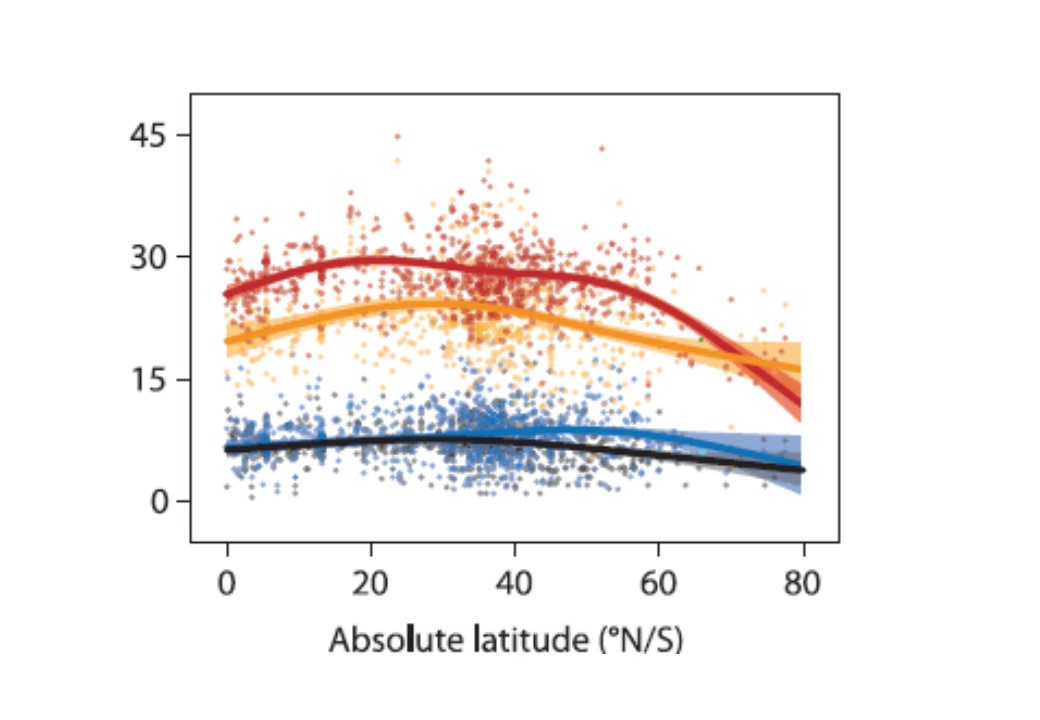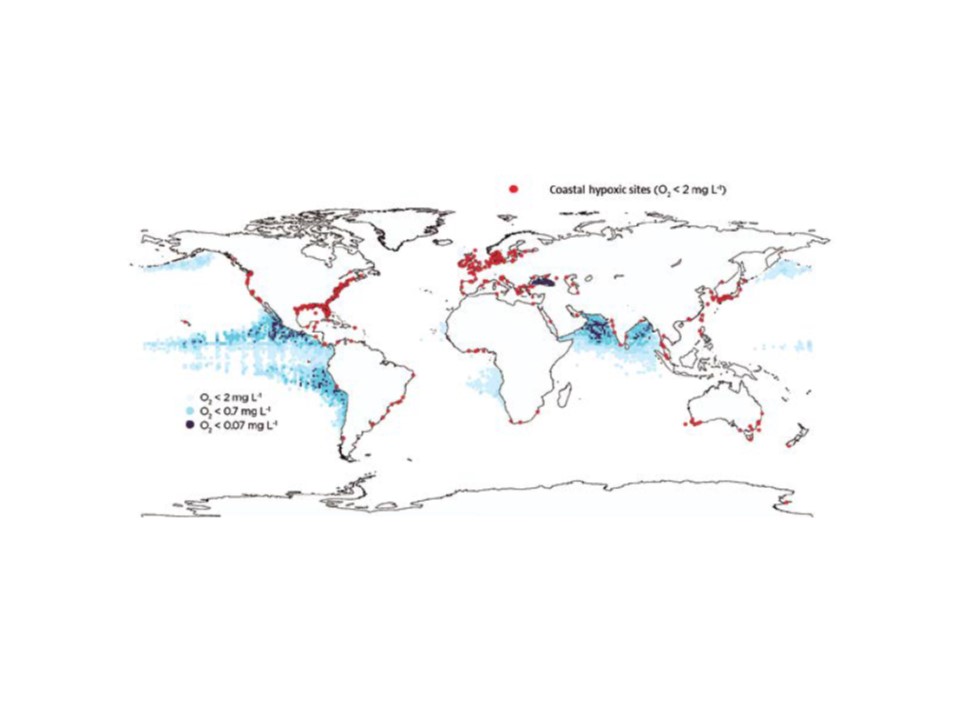Rising temperature affects fish more than previously thoughtLauantai 15.8.2020 klo 21.02 - Mikko Nikinmaa A recent study in Science (Dahlke et al., Science 369, 65–70, 3 July 2020) has evaluated, how fishes are affected by temperature increase associated with climate change. Fish are an increasingly important food source for humankind, so their success in warming waters is of primary importance for feeding human population. Consequently, the ability of fish to tolerate warming waters has been studied intensively. Earlier, it has been estimated that only 5 % of fish populations would be adversely affected by temperature increase predicted to occur by 2100. A lot of fisheries experts have sucked of relief about this, as overfishing  is a major threat presently, and it is thought that overfishing may decrease fish populations by half before 2050. In fact, it has been estimated that temperature increase would make population sizes of fishes larger in some areas. is a major threat presently, and it is thought that overfishing may decrease fish populations by half before 2050. In fact, it has been estimated that temperature increase would make population sizes of fishes larger in some areas.
The limitation of earlier estimations has been that the possibility that possible differences between temperature tolerances of age groups have not been estimated. This was done in the study by Dahlke et al. The results show that temperature tolerance of different age groups of fish is markedly different. The embryos (developing fish within egg cases) and spawning adults (blue and black lines in the figure) appear to have up to 20oC smaller tolerated temperature range than free-swimming larvae or non-reproducing adults (red and orange lines). The difference is greatest at mid latitudes, and decreases both (and especially) in the arctic and near equator. The reason for decreased temperature tolerance is probably due to mismatch between oxygen uptake and consumption. Oxygen uptake is limiting in the embryos enclosed within eggs, whereas the oxygen transport of free-living larvae and juvenile and non-reproducing adults becomes more effective. In spawning adults the oxygen consumption increases without improvement of oxygen transport. Physiological studies about the interaction between temperature, oxygen transport and consumption are needed in different life stages of fish to enable conclusive evaluation of what causes life stage-dependent variation of temperature tolerance. Regardless of the reason, it can be estimated that almost half of the fish stocks will be adversely affected by the temperature increase taking place, if the present international agreements are fulfilled. Together with the reduced stocks because of overfishing this can result in marked reduction in the fish food available to humankind. However, if we would do appropriate climate actions, one could prevent virtually all effects on fish populations. |
|
Kommentoi kirjoitusta. Avainsanat: climate change, fisheries, oxygen transport |
Deoxygenation of oceans is an increasing problem with effets on sealifePerjantai 13.12.2019 klo 18.01 - Mikko Nikinmaa The deoxygenation of the seas has increased markedly during the last 100 years. The areas with reduced oxygen have increased ten times between 1900 and 2000. There have always been oxygen-minimum zones in oceans, but their volume has increased markedly in the recent past, because of decreased ocean circulation and as a result of increased respiration following elevated temperature. In addition to the climate change-caused increase in hypoxic seas, the eutrophication of coastal areas because of human actions have caused pronounced low-oxygen areas especially in the traditionally industrialized western countries.
Spreading hypoxia is a major problem, as it decreases the populations of fish and other organisms. It further affects the species distributions with more preferred species decreasing and decreases biodiversity. The effects of reduced oxygen level as such are aggravated by an increased water temperature, i.e. climate change, because the oxygen consumption of fish and other poikilothermic animals increases with temperature increase. Simultaneously, the oxygen solubility in water decreases. Even this isn’t enough, but the oxygen binding by haemoglobin is reduced at a given oxygen tension with increased temperature. This reduces the capability of fish and other animals to survive in hypoxic conditions. This makes it more difficult of animals to tolerate increased temperature. So, climate change and the pollution of the seas together cause deoxygenation. The pollution further decreases the capability of microscopic algae to produce oxygen by photosynthesis. To combat the deoxygenation problem we need to stop eutrophication, and sea pollution by wastewater cleaning. Further, we need to combat climate change much more effectively than we have hitherto done. We need healthy seas to be able to feed the world, and the current increase in ocean deoxygenation is not doing that. The ocean deoxygenation problem is the subject of an IUCN report, downloadable from https://www.iucn.org/resources/publications. (p.s. I have been studying hypoxia responses in fish from1980). |
|
Kommentoi kirjoitusta. Avainsanat: climate change, aquatic pollution, hypoxia, oxygen transport |
Private cars or not - electric or petrol-fueled?Lauantai 30.12.2017 klo 15.57 - Mikko Nikinmaa Instead of using petrol to fuel your car, you should use use electric car - or not? To evaluate what should be done, one should think not only about illusions, but the life-time ecological (and social) footprint of the product. The problem with electric cars is that making them requires much more resources than making conventional cars. Especially the production of batteries is a problem. This is because they need rare metals, presently mainly mined in places with little environmental concern. The maning wastes often go uncleaned to rivers, and child labour may be used in mining. Normally, it is only thought that burning petrol is the cause of carbon dioxide loading. This is naturally true, but another point should be considered. Oil pollution, to a large part caused by oil transport, is a major reason for the decrease in the photosynthetic ability of marine algae, and thus the removal of carbon dioxide. Consequently, take the train or other forms of public transport. Since the major reason for having private cars is the ease of choosing the time of travel, public transport based on calls would be the choice of future. Minibus taxis should not be a dying breed but a transport system of future. |
|
Kommentoi kirjoitusta. Avainsanat: climate change, fossil fuel, public transport, electric cars |
Another Sad Day for the EnvironmentKeskiviikko 25.1.2017 klo 10.08 - Mikko Nikinmaa The first of my blogs was titled "Sad Days for the Environment", where the fears that the new US president's actions could mean were expressed. Now that Donald Trump has stepped to the office, the fears have already, unfortunately, turned to reality. It seems that the steps taken by President Obama's administration to curb the new oil transport pipelines, exploring oil, etc. are upheaved. However, what is even more fearful is that, if I have understood correctly, employees of EPA are now (temporarily??) prohibited from updating public via press or social media. So only the fantastic desicions the president makes regarding the environment can be made public, and there cannot be any disagreeing views within the government. |
|
Kommentoi kirjoitusta. Avainsanat: EPA, oil transport |
Ecotourism - can tourism ever be ecological?Keskiviikko 18.1.2017 klo 12.30 - Mikko Nikinmaa During recent years something under the name ecotourism has been the most rapidly increasing trend in tourism. The name has been used of all kinds of trips when the destination has been outside the normal tourist attractions and the object has been to visit some nature site. Thus, in many cases for example cruises to Greenland and Antarctica are advertised as ecotourism. In those instances it is easy to say that the travel is far from being ecological. In the easily disturbed Arctic and Antarctic ecosystems such cruises are already one of the biggest causes behind environmental contamination. Similarly, safari tours to see the big game in South Africa are named ecotourism. While every effort can be made to diminish the disturbance caused to the animals, the mere approach is more or less the same as the reason for creating zoos. Actually, in my opinion the major difference is that when zoos were founded, a normal person could not travel to the places where the animals live in their natural environment, whereas with affordable air traffic it is possible today. Ecotourism is defined as "responsible travel to natural areas that conserves the environment, sustains the well-being of the local people, and involves interpretation and education". There are two things that make ecotourism, in my opinion, impossible. The first is that the sites can be reached only by, e.g. air or boat transport (and local car transport) which generate fossil fuel pollution. The second is that if a nature site becomes popular, environment will be necessarily affected. There are, however, a couple of very good things which result from nature tourism (note that I use this word pair instead of ecotourism). The incentive for governments to save the habitats with tourist interests increases. The local people can get the financial benefits from the tourists. In any case we are not talking about ecotourism, because tourism cannot be ecological, but nature tourism, which can have beneficial effects in addition to the negative environmental effects that tourism necessarily causes. |
|
Kommentoi kirjoitusta. Avainsanat: air traffic, transport, environmental effects |
Another smoggy daySunnuntai 8.1.2017 klo 16.01 - Mikko Nikinmaa In the past days one has again seen alarming pictures of the air quality in major cities. The worst ones are from Chinese cities like Beijing, but also big European ones, Paris and Madrid, have been in the news. In Chinese cities the problem has mainly been that the energy production for warming houses and making steel is obtained using fossile fuels, largely coal with poor smoke purification. This is a well acknowledged problem, and the major reason why China has now become a very strong supporter of climate agreements. It is much better to get world's good opinion simultaneously as the number of people getting lung and airway diseases and dying from air pollution decreases. Against this background the opinion of future American president, favouring the use of fossil fuels is an unfortunate cry from the past. The situation of Madrid and Paris is more of a problem. Poor air quality is mainly due to diesel cars. It is not long since diesel motors were considered environmentally friendly. However, their development has not been able to reduce the amount of small particles causing smog. So, one can almost predict that diesel cars are a disappearing feature. Only electric cars with electricity produced using wind, solar or different forms of water energy, are a real long-term solution for clean city air. Note that I have not included energy obtained burning wood, because burning produces both microparticles and carbon dioxide (naturally these can be removed using filters, and much less air pollution to the cities is given up from centralized energy producing units than from individual cars or fireplaces). The removal of carbon dioxide from smoke is of utmost importance. As this is the case, innovations that enable the removal are important for combatting climate change. Recent news have indicated this kind of innovation. The produced carbon dioxide is precipitated as baking soda, which is then used. As a consumer product is the result, the removal of carbon dioxide does not cause cost as long as the product can be sold. Future solutions for cleaner air require changes in thinking. We cannot rely on the solutions from the past, but need to find new ways of thinking. Instead of trying to go back to "Good Old 60's" we should think of ways of having sustainable future. |
|
Kommentoi kirjoitusta. Avainsanat: air pollution, carbon dioxide, transport |

